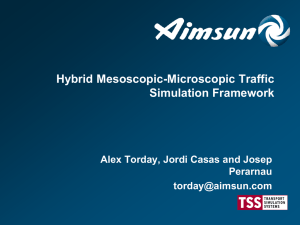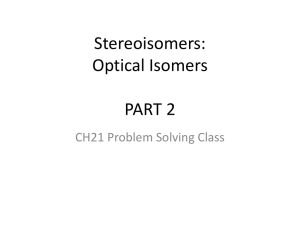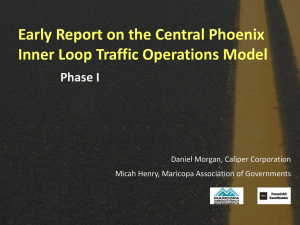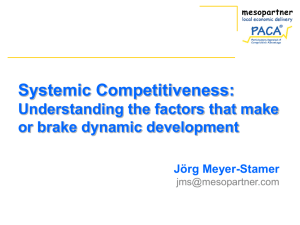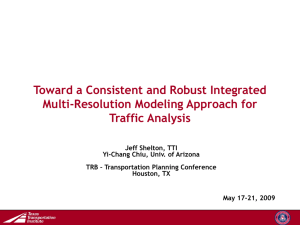Dynamic Traffic Assignment (DTA)
advertisement
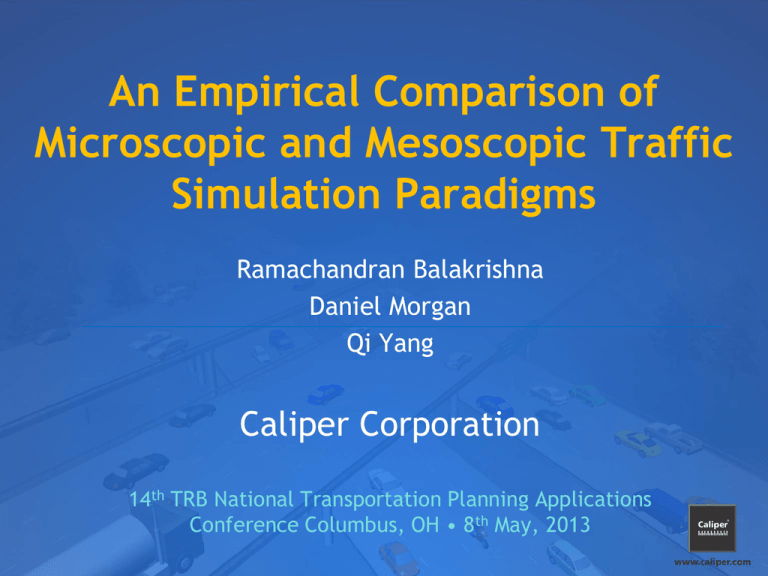
An Empirical Comparison of Microscopic and Mesoscopic Traffic Simulation Paradigms Ramachandran Balakrishna Daniel Morgan Qi Yang Caliper Corporation 14th TRB National Transportation Planning Applications Conference Columbus, OH • 8th May, 2013 Outline • • • • • • • Motivation Dynamic Traffic Assignment Challenges for model comparison Methodology TransModeler overview Case study: Phoenix, AZ Conclusion Motivation • Dynamic Traffic Assignment (DTA) – Demand: short departure time intervals (5-15 min) – Supply: microscopic, mesoscopic, analytical, etc. • Microscopic (micro) vs. mesoscopic (meso) – Micro: Detailed driving behavior, network response – Meso: Aggregate/approximate traffic dynamics, control, queues • Need for objective comparison of micro, meso DTAs – Emissions modeling, etc. require micro fidelity • However, DTA often used interchangeably with meso – Hardware, software advances facilitate micro DTA Dynamic Traffic Assignment (1/2) • General DTA framework Dynamic Traffic Management System Demand Origin-Destination flows Route choice Response to information ATMS, ATIS, APTS Supply - Demand Interaction Supply Network Traffic control Incidents and events Traffic assignment Flow propagation Traffic Conditions Flows, densities, speeds, travel times [Source: Ben-Akiva, Koutsopoulos, Antoniou and Balakrishna (2010) “Traffic Simulation with DynaMIT”. In Barcelo (ed.) “Fundamentals of Traffic Simulation”, Springer.] Dynamic Traffic Assignment (2/2) • Network loading (supply) – Microscopic • Small time steps (0.1 second) • Car following, lane changing, reaction times • Explicit models of traffic control, lane utilization • Routing utilizes lanes, intersection geometry and delays • Outputs: Detailed trajectories, realized capacities – Mesoscopic • Large time steps (several minutes) • Macroscopic traffic dynamics e.g. speed-density functions • Approximate models of signals, lanes, capacities • Routing based on link-node representation • Outputs: Aggregate link performance Challenges for Model Comparison (1/2) • Traffic simulation tools differ significantly – Software architecture • Data structures, loop implementation, procedures – Modeling features, assumptions, simplifications • Vehicle and user classes, value of time (VOT) • Network representation – Lanes, lane groups, turn bays • Shortest path, vehicle propagation algorithms – Default parameters – Visualization and output generation Challenges for Model Comparison (2/2) • Literature review indicates diverse tool-dataset combinations – Comparison of existing studies is difficult • Need for calibration to common traffic data • Unclear methodologies for prior calibration • Differing performance measures, thresholds – Often impossible to replicate datasets across tools • Limited documentation of algorithms, assumptions • Missing data – Example: “stick” network, missing lane geometry info • Incompatible modeling assumptions – Example: single VOT, restricted signal timing plans Methodology • Eliminate errors due to tool differences – Common platform for micro and meso • Shared software architecture • Consistent network representation logic • Identical input formats • Directly comparable outputs – Common dataset • Highway network • OD matrices, vehicle classes • Historical travel times, turn delays – Common model settings • Route choice model parameters, turn penalties, etc. TransModeler Overview • Scalable micro, meso, hybrid simulation • Built-in Geographic Information System – Network accuracy, model fidelity, charting • Explicit handling of complex traffic control • Intelligent Transportation Systems (ITS) – High Occupancy Vehicle/Toll (HOV/HOT) – Electronic tolls (ETC) – Variable/Changeable Message Signs (VMS/CMS) • Dynamic Traffic Assignment (DTA) Case Study: Phoenix, AZ (1/5) • Central Phoenix – Maricopa Association of Governments (MAG) • Spatial extent – – – – 530 sq. miles; 890 zones 17,000 nodes 23,000 links; 35,000 segments 1,800 signalized intersections • AM peak period – 6:00-9:00 AM – 812,000 trips Case Study: Phoenix, AZ (2/5) • Micro model calibrated to match dynamic traffic count data – Time-varying demand – Congested travel times – Turn delays • Validated against INRIX speeds • Calibration and validation in subsequent presentation Case Study: Phoenix, AZ (3/5) • Micro fidelity run times – 3.1 GHz Intel Xeon Dual Core 64-Bit CPU, 64 GB RAM – Averages from five replications Case Study: Phoenix, AZ (4/5) • Comparison of segment flows – Default node delay calculations in meso – Indicates need for further capacity calibration in meso Case Study: Phoenix, AZ (5/5) • Comparison of segment travel times – While meso is close, micro provides output fidelity Conclusion • TransModeler – Objective platform for comparing fidelities • Microscopic fidelity – Feasible for planning applications • Practical run times on desktop hardware • Provides detail for modeling emissions, tolls, etc. – Additional calibration burden for meso • Needs more work to bring supply closer to reality • Next steps: more tests – Compare queue lengths, point-to-point travel times – Test different meso delay models – Quantify variance from multiple runs

